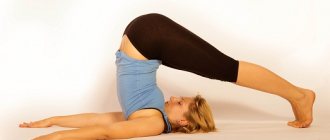What are the benefits of yoga
Yoga is the oldest Indian tool for achieving internal and external peace, as well as unity with the world . Thanks to a targeted set of exercises, any person can achieve the desired well-being. In other words, it is advisable to correctly develop a program using freely available exercises in order to achieve the goal.
At the same time, the main advantages of the weight loss method include:
- Improving the general condition of the body, including normalizing metabolism.
- Flexibility. A weight loss program can be developed for almost every person.
- Improving potency . The right program will not only take care of those extra pounds, but will also restore male strength.
- Strengthening women's health . Systematic exercises stimulate cells to rejuvenate and increase elasticity. You will begin to feel more youthful, and this is guaranteed to show in your appearance.

- New perception of life . Yoga classes motivate and change your thinking. You will have new goals and energy to achieve them.
- Inner peace . All worries and grievances will finally begin to leave you, leaving only experience behind. You will learn to accept the world around you as it is.
- Increasing your reserve of strength . After just a few sessions, you will feel toned, allowing you to perform much more everyday tasks than you are used to.
- Normalization . The weight doesn't just go away. You achieve ideal proportions that will return normal well-being and cheerfulness to your image.
What time of day is it best to exercise and what is the optimal duration of exercise?
Indian yogis begin their practices in the morning at dawn, and it is no coincidence. Morning yoga helps you wake up and recharge your batteries for the day. It is the morning hours that are considered the best for yoga. Unfortunately, not everyone has time for full-time studies in the morning. Don’t be upset: 20–30 minutes are enough to perform morning asanas to increase blood circulation, start metabolism, warm up joints and muscles, and prepare the whole body for the working day.
How to find the right motivation for losing weight:
Especially for beginners, you need to approach the choice of exercises for morning warm-up wisely - the risk of injury is higher in the morning. For a morning routine, leisurely stretching exercises that do not require much effort, such as cat pose or butterfly pose, are more suitable. Strength and dynamic loads are best left for evening workouts.
Find out what other exercises to choose for your morning routine from the video.
Video: fifteen-minute complex for awakening from Katerina Buida
The optimal duration of a yoga session is from one and a half to two and a half hours, depending on the level of training. The duration of training time should be increased gradually. You definitely need to exercise regularly, at least 3-4 times a week. At first, you shouldn’t exhaust yourself with daily exercises - the body, especially an unprepared one, needs days of rest.
Those who cannot sleep for a long time and feel exhausted in the morning should pay attention to a set of exercises before bed. To avoid problems with falling asleep, the room must be ventilated the night before, and the last meal should be 3 hours before bedtime.
You can start the complex with the Sirshasana (headstand) exercise, but you need preparation for it: lying on your back, you first need to relax as much as possible, then inhale and exhale smoothly, imagining how the air comes out of all parts of the body. Now you can go to the wall and stand on your head, trying to hold in this position for as long as possible, ideally up to 3 minutes.
The Viparitakarani mudra exercise, which is reminiscent of the familiar “birch tree” exercise, is also good before bed: from a lying position on your back, you need to lift your legs off the floor, with your elbows resting on the floor and your palms on your lower back. You should stay in this position for 2 minutes.
More yoga exercises before bed are in the video tutorial by Katerina Buida.
Video: evening complex “Sweet Dream” from Katerina Buida
Basic rules of yoga
In order for yoga for weight loss to be as effective as the Tabata program, try to take into account the fundamental rules with all your inherent responsibility. You will quickly experience results only if you show your discipline.
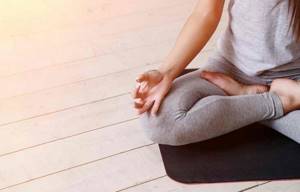
The basic rules of yoga include:
- Systematicity. Make your classes regular, on certain days and times.
- Experienced instructor . If you are new to yoga, be sure to seek out an experienced teacher. Only he will point out the main mistakes and give you instructions on how, for example, to increase flexibility and relax the body through special breathing techniques.
- Choose a clean place. An important point in yoga is the place where you plan to do the complex. It should be bright and calm. It is important to choose the right place, as it will form the overall mood of the complex.
- Move gradually . Don't jump into difficult poses right away. Go to them gradually, without overworking your body. This way you can develop your technique and eliminate possible problems associated with the lack of physical ability to perform this or that action.
- Be aware of every movement . An important element of yoga is awareness. You must clearly understand why you are doing this or that pose.
Principles of nutrition combined with exercise
Regular yoga practice can gradually lead to changes in eating habits. Yes, all yogis are vegetarians, but this does not mean that you should immediately adopt vegetarianism. Yoga teaches you to feel your body, and over time you will want to eliminate obviously harmful foods from your diet. If you are not yet ready to radically change your eating behavior, then the consumption of certain foods should be limited and minimized.
Meditation for weight loss:
Yoga is considered harmful:
- Any meat contains many toxic substances that promote premature aging and cause aggression.
- Any animal fats, including dairy products, cause atherosclerosis.
- Any drugs, including alcohol, tobacco, tea, coffee, opium, hashish, marijuana and other drugs.
- Any sweets, except honey and candied fruits.
- Any flour products, especially those made from yeast dough, have a detrimental effect on the intestines.
In yoga it is considered correct when:
- 60% of the diet consists of natural raw food: fruits, vegetables, herbs, nuts;
- 40% is food that has undergone heat treatment.
By observing this ratio, you can create a healthy menu for every day according to your taste.
Basic asanas for weight loss
Having studied the rules and basic principles of yoga, you can begin to become familiar with the poses that will allow you to quickly lose unwanted pounds. And then we invite you to familiarize yourself with several options for movements aimed at completing the task directly in certain problem areas.
Note! The constant practice of yoga allows not only to bring the body into proper shape, but also increases a person’s personal concentration, and also improves the speed of thinking.
For the belly
Traditionally, one should start with the most problematic area, and the stomach in this case is a more than reasoned example.
Bhujangasana
This is the first pose we will look at. Its essence lies not only in losing extra pounds, but also in thoroughly working out the abdominal muscles. The purpose of the exercise is to strengthen the upper body while giving flexibility and strength to the back.

To perform the exercise, lie on your stomach on the mat and rest on your palms, which should be located directly under your shoulders. Your toes and chin should also touch the floor. As you inhale slowly, lift your body on your arms and bend your back as far back as possible.
You need to stay in this position for 15 to 30 seconds. Then, while exhaling slowly, you should return to the starting position. It is advisable to repeat the weight loss exercise with breaks of 10-15 seconds, at least 5 times.
Dhanurasana
This pose aims to strengthen the core of the abdomen, as well as improve digestion and flexibility throughout the body. To perform, lie on your stomach, bend your knees, grab the outside of your ankles with your hands and lift your shins. Next, take a deep breath and bend well, lifting your pelvis and chest off the floor.
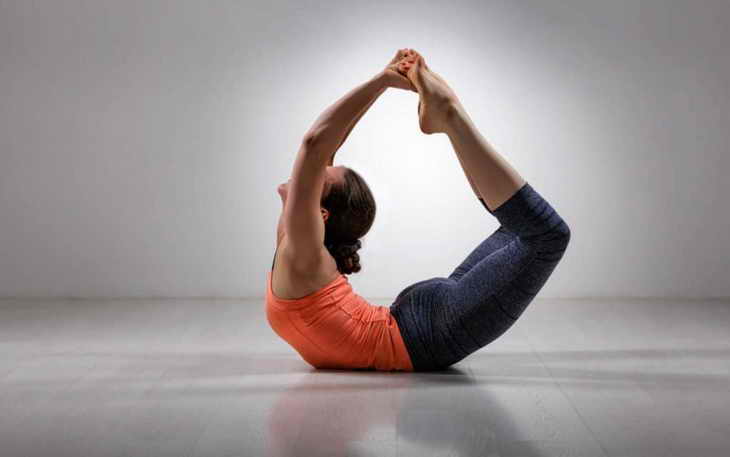
The head must also be moved back as far as possible. You need to stand in this position for about 15-30 seconds , and then return to the starting position at the exit. Repeat 5 times with a break of 10-15 seconds.
Note! For a better effect, you can swing a little while lifting.
Naukasana
This pose is aimed at burning fat in the waist area. It also has a positive effect on appetite and leg muscles. To begin, you need to lie on your back, stretch your legs and place your hands along your body, palms up. Inhale slowly and raise your legs. Don't bend your knees, try to raise them as high as possible and keep them straight.
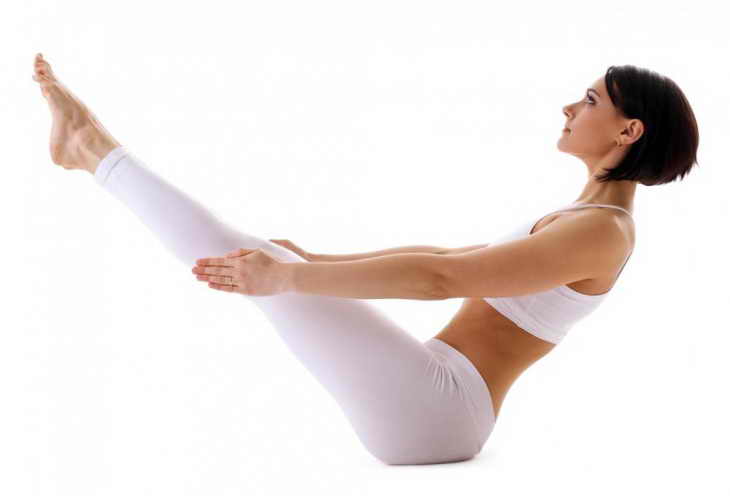
Next, try to touch your toes with your hands. With all this, you must keep your body at an angle of 45 degrees. You must remain in this position for at least 15 seconds, then return to the starting position and repeat after 15 seconds. In total you need to do 5 exercises.
Kumbhakasana
This pose is often called plank. As a result of doing this, you not only lose excess weight, but also take care of strengthening the muscles in your arms, legs, back, stomach and neck. The classic version of the pose requires you to kneel and place your hands in front of you.

Next, you should straighten your legs, standing on your toes, and raise your head, looking in front of you. From head to toe, your body should display a single straight line. You need to stay in this position for 15 to 30 seconds . It is necessary to repeat 5 times with breaks of 15 seconds.
Pavanamuktasana
A pose designed to strengthen the abdominal and hip areas, as well as reduce pain in the lumbar region. In addition, proper implementation normalizes intestinal function, reduces acidity and significantly speeds up metabolism. The exercise will have you lie on your back, extend your legs and place your arms parallel to them.

Next, as you inhale, stretch your legs, keeping your heels together, and as you exhale, bend them at the knees and slowly bring them to your chest. Grasp them with your hands and hold the position for 60-90 seconds. Then exhale and return to the starting position. This operation must be done 5 times with a break of 15 seconds.
Note! It is important to breathe deeply throughout the procedure.
For legs
Often, legs also suffer from poor diet or lifestyle. That is, you may also need to remove fat from them. To do this, check out the following asanas.
Utkatasana
It's quite simple to do. Standing straight, squeeze your feet tightly, raise your arms up with your palms facing each other and squat until a right angle is formed at your knees. So you need to stand for 2 to 5 minutes and try to strongly pull your spine up. Lift slowly, without jerking.
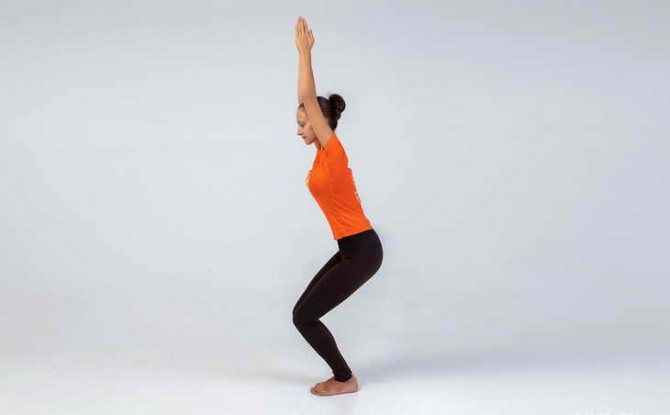
Sarvangasana
This pose is popularly called “birch tree”. Lie flat on the floor, and then, as you exhale, lift your legs above your head. Feet should be together. At the same time, try to tear off your lower back. Secure your body in your arms using the lever. You should stay in this position for as long as possible, remembering to breathe deeply. Next, slowly return the body to its original state.
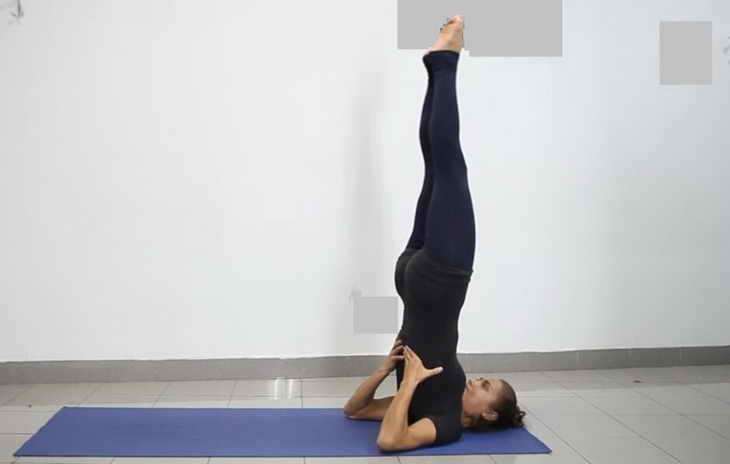
Note! Thanks to numerous studies, experts have been able to prove the fact of a significant reduction in anxiety and improved well-being in people who systematically practice yoga.
For the back
Oddly enough, the back also suffers from excess weight, especially with a long-term incorrect lifestyle of the individual. To get rid of the accumulated effect, yoga also provides special poses.
Virabhadrasana II
A practical way to strengthen your back muscles and remove deposits from them. While in a standing pose, jump up a little and spread your feet about 130 cm apart . Next, spread your arms out to the sides. The palms must be facing the floor.
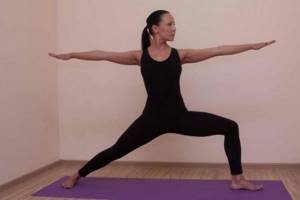
Turn your right foot so that it is at a right angle and points to the right side. The left leg also straightens at this moment and rotates slightly, and both legs should remain on the same line. The right leg needs to be bent at the knee to 90 degrees.
Direct your right hand along your right leg, and your left hand, respectively, along your left. Turn your head towards your bent knee. You need to stay in this position for 1 minute and then change sides.
Shalabhasana
Lie on your stomach and place your arms along your body. Next, simultaneously begin to pull your head, chest, arms and legs back. The stomach cannot be opened . Be sure to tense your buttocks as you rise. You need to stay in this position for as long as possible.
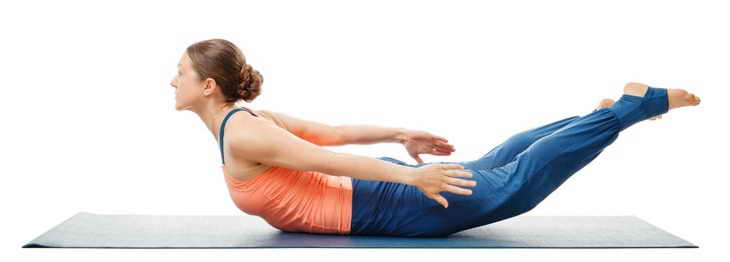
For hands
Another group of exercises that we will look at are hand poses. They, just like the legs, are subject to serious effects from fatty deposits. To restore muscle tone and an attractive appearance to your arms, perform two simple exercises.
Adho Mukha Svanasana
Get on all fours with your feet and hands shoulder-width apart. Press your toes into the ground and slowly come out into the pose, keeping your knees aligned as you do so. The foot should be completely on the floor. Do this pose for at least a minute . Then, returning to the starting position, take a break for 15 seconds and repeat the cycle a couple more times.
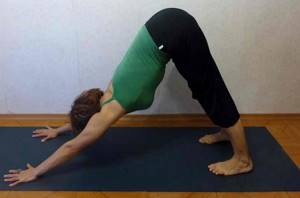
Vasisthasana
This pose is aimed at restoring the muscles in the arms. Get on all fours. You will need to turn your arms and legs vertically and transfer your body weight to your left hand. Next, lift your right hand off the floor and turn your whole body forward so that your left hand and knee are on the floor.
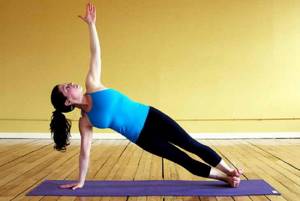
The rest of the body must be in a horizontal plane. Breathe with your stomach and hold this position for as long as possible. Then repeat the same process for the opposite hand.
What types of yoga exist and what should beginners choose for weight loss?
The main question that plagues beginners who decide to take up yoga is which direction to choose? Indeed, there are many styles of yoga, and their choice depends on what goals you want to achieve.
If the main goal is weight loss, then Bikram yoga and Ashtanga yoga will be the most effective, although, by and large, all types will ultimately help you lose weight.
- Bikram yoga (also called “hot” yoga) is a type of hatha yoga and consists of 26 dynamic asanas and 2 breathing exercises that need to be performed in a well-heated room with high humidity. Such workouts can burn up to 700 calories per session. The downside is that not all schools can create the necessary conditions for this, so Bikram yoga is not practiced everywhere.
- Ashtanga yoga is a rigorous, dynamic practice that allows you to build “lean” muscles. You can burn up to 600 calories in one session. This type of yoga involves following a path consisting of eight steps. Each next level exceeds the previous one in difficulty. Asanas are combined with breathing practice (pranayama) and repetitive movements associated with breathing (vinyasas).
- Hatha yoga is the initial stage of raja yoga, its purpose is to physically prepare the body for meditation using a set of physical and mental practices that temper the body and spirit. This is a set of static asanas that allow you to deeply work all the muscles and speed up your metabolism.

These exercises help improve muscle elasticity
- Strength or power yoga was developed in America in the mid-90s. It is based on Ashtanga yoga exercises, but the asanas are not performed in a strict sequence. Power yoga classes train endurance and give fairly quick results. At the initial stage, static hatha yoga exercises are used, while the muscles of the legs, arms, back and hips are well worked out, and muscle imbalances are leveled out. At a more advanced level, when students already have full control of their body, they begin dynamic exercises.
- Kundalini yoga is a synthesis of static, dynamic, breathing exercises, meditations and mantras. The complex of all these practices allows you to awaken the Kundalini energy, “dormant” at the base of the spine, and raise it gradually through the energy channels upward, to the highest chakra, Sahasrara.

Practices are aimed at working with consciousness, they develop the ability to observe your thoughts, emotions, sensations, and help you to know yourself better
Perform several exercises with kundalini yoga teacher Alexey Vladovsky.
Video: kundalini yoga lesson for weight loss
- Breathing yoga is a set of special exercises aimed at holding the breath and accumulating carbon dioxide in the body, which helps relax blood vessels. In relaxed vessels, blood circulation is normalized, which increases the overall tone of the whole body. Short hypoxia helps accelerate the synthesis of enzymes that trigger oxidation processes in the body. As a result, metabolism increases and metabolic processes improve.
A video lesson from Karina Kharchinskaya will help you learn more about the principles of breathing.
Video: learning to breathe correctly
- Yoga for the fingers or mudras is based on the fact that there are acupuncture points associated with various organs on the palms and fingers. Regular exposure to these points helps to cope with stress, improve vision, hearing, speed up metabolism, alleviate many ailments, and also maintain the overall tone of the body.
- Yoga in hammocks is perfect for people who find it difficult to perform traditional exercises for a number of reasons, for example, joint problems or back problems. Such exercises are useful for obese people and women after childbirth. Classes take place in a special hammock, consisting of a canvas equipped with additional handles and ropes for fastening. Indoors, the device is attached to the ceiling with carabiners, and in the summer you can attach it to a tree or an outdoor horizontal bar to practice outdoors.
Tips for increasing efficiency
In order for yoga for weight loss to bring the same positive effect as aerobics, we recommend that you do not neglect the general rules that are interpreted by famous mentors from around the world.
Information: UNESCO has included yoga in the list of intangible cultural heritage.
To improve efficiency:
- Don't overeat.
- Avoid any food flavored with spices.
- Avoid sweets and starchy foods.
- Go vegetarian if possible.
- Avoid tea and opt for purified water.

Rules and features
When including yoga exercises for weight loss in your daily practice, try to adhere to the following rules:
- exercise on an empty stomach: no earlier than 3 hours after eating;
- move from simple to complex. Do not try to immediately perform difficult poses, as this will discourage you from being physically active;
- ventilate the room before practice;
- be sure to warm up before starting asanas , especially in the morning;
- master proper breathing;
- choose clothes that do not restrict movement.
Even for a simple complex, use a special mat. Its non-slip surface allows you to perform poses safely.
You may also need a yoga strap. This piece of equipment is used for effective stretching. For example, if you cannot reach your legs with your hands, then a belt will come in handy.
When relaxing, use a blanket to keep warm or catch a cold after intense practice.
Contraindications
Like running for weight loss, the method of losing extra pounds discussed in the article has a number of contraindications that you must take into account.
Attention! Neglect of these factors will worsen your overall well-being and, quite possibly, lead to serious pain and complications.
To prevent this from happening, try to visit your family doctor before starting classes and do a full examination of your body. Also try to remember the main list of contraindications.
It is forbidden to practice yoga for weight loss if:
- General severity of the condition. For example, when you have been struggling with some kind of disease for a long time and have already become quite weak.
- Mental disorders.
- Organic lesions of the cardiovascular system. It is forbidden to practice yoga if you have heart disease, tachycardia, arrhythmia and aneurysms.
- Blood diseases and various infectious injuries of the musculoskeletal system.
- Severe TBI and severe spinal injuries, as well as in violation of the general structure of the body.
- Malignant neoplasms.
Useful videos
Whatever variations of weight loss techniques you consider, be it walking or the Eastern principle we study in the post, be sure to pay attention to additional materials. Next, we invite you to watch a thematic video in which experts describe current exercises for quickly losing extra pounds. Moreover, in addition to the asanas themselves, you will learn many nuances about how to correctly perform certain exercises.
A set of morning exercises for beginners.
Yoga is a tool for achieving an impeccable internal and external state . Every year there are more and more practitioners of this art, which is a fundamental sign of high efficiency. Find a responsible mentor, master all the subtleties and nuances of the exercises you need to lose weight, and achieve an ideal figure with minimal effort.
A set of exercises for weight loss
In advance, before you start fighting excess kilograms, it is recommended to choose a set of exercises that will most effectively affect your figure. The most popular is Surya Namaskar. Morning exercises will take about a quarter of an hour:
- With your feet firmly planted on the floor, stretch upward.
- Raise your hands clasped in your palms and bend your back.
- Without bending your legs or rounding your back, try to touch your forehead to your knees.
- Take a step back, at the same time lowering to your knee, lift your face up, repeat with the other leg.
- Stretch your tailbone up, point your chest and heels down, imagining yourself as a triangle.
- Get down on your knees, trying to also touch the floor with your chest.
- Lean forward, arching your back.
- Return to triangle pose again.
- Touch your chest with your left foot, bend your right limb, resting your knee on the floor.
- Connect your legs and touch your forehead to your knees.
- Straighten up, arching your back.
- Take the original position and relax.
Losing weight with yoga, if you carefully and diligently perform all the approaches, will be possible in a short time - about 3 kg will be lost in a week. It should be remembered that the morning lesson should be preceded by a light warm-up - do a few simple movements.
Yoga is an ideal way to lose excess weight if you don’t have time to go to the gym and don’t have enough willpower to diet. You should not expect that fat deposits will begin to rapidly disappear if you devote a minimum of time to exercise. It is recommended to devote at least a quarter of an hour to exercise a day - only this will allow you to enjoy the desired results.






